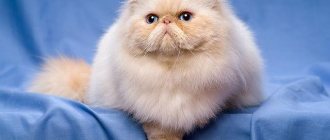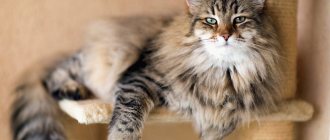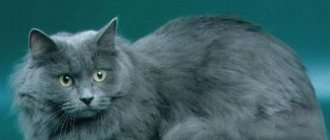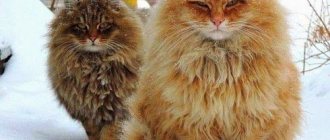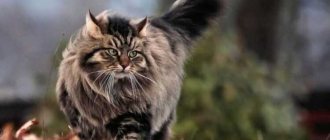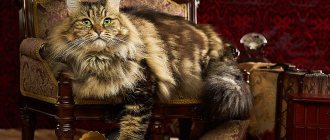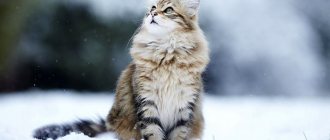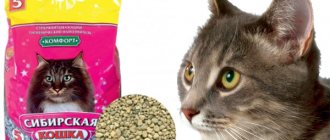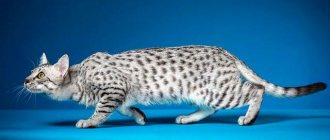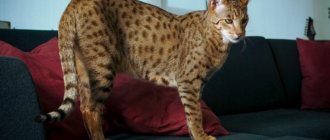Siberian cats are spectacular and powerful animals with a luxurious coat and a unique disposition. They very organically combine developed hunting instincts, beautiful exterior and high intelligence.
Let's figure out what features are hidden behind the respectable appearance of Siberian cats and how to make living together with them as comfortable as possible.
Brief history of the breed
The first mentions of large cats from Siberia date back to the 16th century. Presumably they came to these lands with Asian traders from Bukhara or together with settlers from the western part of Russia.
Experts are convinced that these animals mated with forest cats in their natural environment, as a result of which their descendants developed thick, long hair that could reliably protect them from the harsh climate.
Selection work to consolidate the best qualities of Siberians began in 1986. To distinguish the breed, felinologists wanted to call it “Moscow semi-longhair”. But since large shaggy cats evoked associations with Siberia, they began to be called “Siberian”.
In 1989, the breed was registered in the USSR. A year later, its standard was sent to leading international felinological associations. As a result, in 1992, Siberians received official status in the WCF. A little later, the breed was recognized by CFA, FIFE and TICA.
Head
The head is trapezoidal in shape, its contours are significantly rounded, they range from medium to large in size, the head is in perfect harmony with the body. The upper skull of the head is completely flat, and becomes slightly narrower towards the chin.
Their ears are usually of medium size and rarely large, they slope forward and are rounded. The fur on the back of the ears is thin and short. On the ears, towards the end, you can see tufts, the same as those seen on a lynx or squirrel.
The eyes are large and expressive. The color of the eyes does not depend in any way on the color of the coat. The chin is rounded, but not protruding. At the top the head is almost flat, the nose is slightly curved.
Interesting Facts
During the existence of Siberian cats, many interesting things have been associated with the breed:
- The unique fur of animals of this breed almost never causes allergic reactions.
- The Siberian cat of the famous politician Dmitry Medvedev, named Dorofey, took part in one of the popular TV shows.
- There is a unique place in Tyumen. It is called “Square of Siberian Cats” and is dedicated to the animals who saved priceless exhibits of the Leningrad Hermitage from rats during World War II.
Siberian cat screams in the house
If your Siberian cat is wandering around the house and screaming, then first you should find out the reason for this strange behavior:
- One of the most common reasons is natural instincts. In such cases, it is urgent to sterilize the animal, give it a sedative with food, or introduce it to someone.
- If your pet is in pain, you should carefully examine it and take it to a veterinarian for examination.
- Some factor irritates or worries the Siberian. Observe the animal and fix the problem.
- The animal suffers from nocturnal hyperactivity. To get rid of this condition, prevent your pet from sleeping in the evening, try to occupy him with something, for example, playing with a teaser, a ball, or a laser pointer.
Breed description, standards, appearance
Siberian cats are large animals with strong, muscular limbs and luxurious shaggy hair. Thanks to the luxurious “jabot” and graceful muzzle, representatives of the breed have a presentable lordly appearance. A detailed description of the Siberian cat is presented in the official standard.
Dimensions and weight
Representatives of the Siberian breed are distinguished by their impressive dimensions. Cats weigh about 4-6 kg. The weight of cats varies between 7-10 kg. However, there are cases when the weight of Siberians reached 12 kg.
On a note. Due to developed sexual dimorphism, a cat does not look as representative as a male cat.
Anatomical characteristics
Ideally, a Siberian cat should fit the following description:
- The head is trapezoidal, with a smoothly contoured muzzle, full cheeks, a pronounced chin and low-set, developed cheekbones.
- The ears are medium in size, slightly tilted forward. Wide at the base, gradually tapering to slightly rounded tips.
- The eyes are oval, medium in size. They have a wide, slightly slanting stance. The iris is yellow or green. A white cat of the Siberian breed may have multi-colored or blue eyes.
- The body is dense, massive, slightly elongated. The neck is short, the back is strong, the chest is voluminous.
- The limbs are thick, with developed muscles and large rounded paws. The interdigital space is overgrown with bristly tufts of hair.
- The tail is fluffy, of medium length, wide at the base, gradually tapering to a rounded tip.
Color and coat type
The Siberian forest cat has coarse, dense outer hair and soft, dense undercoat. The shiny awn has water-repellent properties. It completely covers the back and falls evenly onto the sides and base of the Siberian's tail.
On a note. The winter coat of Siberian cats is much longer than the summer coat. During the cold season, they develop a chic collar and fluffy pants. In warm weather, the Siberian can look like a smooth-haired cat.
Cats of this breed have several color options. According to the standard, the color of Siberians can be:
- All different intensities. The main solid colors include red and black. Each of them has a clarified counterpart. Red corresponds to a cream shade, black – gray (blue). The white Siberian cat is considered very rare and cannot have any patterns or inclusions on its fur.
- Tortoiseshell color is a combination of several shades. It is essentially a calico cat with white markings evenly distributed across its body, as well as cream and blue or red and black spots. Tortoiseshell coloring is typical for females. Siberian cats with this color are born extremely rarely and, as a rule, do not give birth.
- Smoky and silver. These Siberians have a two-color coat. Their hairs have a white base and a dyed tip. Silver cats of the Siberian breed have a pattern, while smoky cats do not.
- Tabby (wild). This color is an alternation of dark and light pigment, which creates a spotted, brindle or marbled pattern on the Siberian’s body.
- Chinchilla. This color is rarely found in Siberian cats. Chinchilla hair has 2 stripes: dark at the tip and light at the base.
- Gold. A difficult color to fix, in which the Siberian's fur coat is painted in a warm apricot shade.
Diseases
The Siberian cat has a strong immune system, but this breed also has a number of problems. Most, fortunately, can be dealt with, you just need to seek help in time.
- Periodontal disease is a common disease among Siberians. The reason is the distant crossing of the forest Siberian breed with the Himalayan and Persian cats to consolidate physical characteristics. The provoking factor is poor nutrition and poor oral hygiene control by the animal owners. Damaged teeth have to be pulled out.
- Oncology – occurs in Siberian cats with white fur. With timely diagnosis and treatment, the animal lives quite a long time.
- Polycystic kidney disease is diagnosed in older cats. Cysts begin to grow, which gradually fill with fluid and negatively affect the functioning of the kidneys. There are no preventive measures, so animals with poor heredity should not be bred.
- Kidney stones and other pathologies of the lower urinary tract. Almost all are treatable.
- Hypertrophic cardiomyopathy is a thickening of the heart muscle. In Siberian cats, even kittens suffer from the disease (in other breeds, the disease manifests itself in old age). It cannot be cured, but early diagnosis and supportive therapy can prolong the cat’s life for many years.
If your pet begins to hide in corners, eats poorly, behaves restlessly, or vice versa - moves little, vomits or blood is found in its feces - immediately take the cat to the veterinarian!
Expert opinion
Dusheba Vera Ivanovna
In 2010, she graduated from the Moscow State Academy of Veterinary Medicine named after K.I. Scriabin with honors, specializing in veterinary medicine. I regularly attend veterinary conferences, congresses, and webinars.
Do not ignore vaccinations, even if your pet lives in an apartment and does not come into contact with other animals. The causative agents of plague, chlamydia, viral rhinotracheitis and the like can be brought into your home very simply: on your shoes or clothing, on your hands and other objects. The first vaccinations are given to babies at 3 months, they are first given an anthelmintic drug (7-10 days before the procedure), and revaccination is done a month after the first vaccination. Keep in mind that this is a burden for a small organism, so if your pet is sick, or his teeth are changing, or he needs to be transported to a place with a different climate, postpone vaccination for a while.
In the photo there is a Siberian cat on a walk
Character and temperament
Siberians are active and playful cats with a developed sense of self-esteem. They are very reserved, talkative and subject to sudden mood swings. Representatives of the breed do not like it when communication is forced on them, but they themselves will not bother the owner when he is busy.
The proud and independent character of the Siberian cat does not interfere with getting along well with all members of the household, including children. The main thing is that the child understands that the animal is not a toy and knows how to properly handle the pet.
Siberians get along well with dogs and other cats. Despite their strong character, representatives of the breed do not strive to dominate other pets. True, the innate habits of a hunter prevent Siberians from being calm around rodents.
Buy a Siberian kitten
It is clear why the Siberian cat has become so popular in Russia and other countries of the world: its external characteristics attract the attention of numerous fans of cats with long hair.
There are enough nurseries where you can buy pedigree Siberians to avoid purchasing a cat with a provenance of dubious quality. If you pick up a kitten from your hands, there is a high probability that it will grow up not into a proud Siberian, but, at best, into a Norwegian forest cat, if you're lucky.
Siberian catteries offer to pre-book a kitten of a suitable class. On average, the cost of the Siberian breed is not particularly high by the standards of the cat market. Purchase cats aged 2.5-3 months, vaccinated and healthy, with the pedigree indicated in the metrics. Buying an inexpensive pet from someone who is supposedly of this breed is fraught with the lack of any documents at all.
The price for cats of the Siberian breed starts at a threshold of 5,000 rubles
and depends on the exterior of the animal and the characteristics of its pedigree.
What to name a Siberian kitten
Choosing a name for a new family friend can sometimes be difficult. When giving a kitten a nickname, people must understand that it should not only please them, but also suit the animal, its external characteristics, and habits. Most importantly, the Siberian cat should easily perceive its name, and, therefore, respond to it easily.
It’s better to come up with a nickname in advance, as the nursery will ask you what name to put on your passport. Many breeders, by old custom, expect the name to reflect the pedigree.
Names for boys and girls can be different, or they can be completely similar. It is worth sitting down and discussing with the whole family what is the best name for a Siberian cat , for this you should use a list of the best nicknames.
Name table
| Girl | Boy | ||
| Redhead Squirrel Cassie Frosya Dara Bonna Athena Mina Shiba Pusha Chunya Laska Eva Zira Rikki | Finn Vyusha Nyusha Rady Basya Vetka Fenya Lada Pear Chishka Dora Plyukha Fanta Kama Era | Chester Maurice Yust Ty Argon Archie Axel Cyber Cruz Bucks Miguel Smokey Pat Fluff Ivor | Erema Patrick Norman Light Evrik Samson Sam Charlie Shrek Cupcake Yukki Veles Karen Murik Nord |
How to choose the right kitten
To avoid becoming a victim of scammers, it is better to look for a potential pet in certified nurseries or trusted breeders. It is advisable to buy a Siberian no earlier than he is 3-3.5 months old. By this age, he will already have all the vaccinations and documents confirming his breed.
Kittens should be curious, well-groomed and moderately well-fed. They should not have a bloated belly, sour eyes, matted hair, foul mouth, discharge from the ears, dirt under the tail or scratching on the skin.
Kitten care
Responsible breeders do not separate babies from their mother before they are 3 months old. Therefore, by the time the Siberian kitten moves to a new home, it is already quite independent. He is litter box trained, knows how to use a scratching post, and eats many foods with gusto. The owner can only give the pet time to get used to the new environment and show where its bowls, toilet and place to sleep are.
In order for the little Siberian to adapt faster, they communicate and play with him more often. And so that the kitten’s curiosity does not lead him to trouble, all wires, household chemicals, small objects and indoor plants are hidden in the house. Also, for safety reasons, do not leave windows, oven doors or washing machines open.
What affects life expectancy
The average life expectancy indicators reflected in statistics are directly influenced by:
- features of heredity;
- the quality of the diet used to feed the animal;
- compliance with the fundamental rules of caring for a pet;
- timely castration or sterilization;
- strict adherence to the vaccination regime;
- systematic preventive measures.
As practice shows, castrated and sterilized cats will live significantly longer than their fellow Siberian breeds capable of reproducing offspring. This feature is associated with low production of sex hormones and minimizing the risk of stressful situations caused by the need to find a partner for mating.
According to experts, animals bred by selective breeding do not have any significant differences from the characteristics of aboriginal cats, therefore the statement that the life expectancy of purebred individuals is too short is erroneous.
This is interesting! Sufficient attention and competent care of the owner for his pets of the Siberian breed, as well as the manifestation of love, affection and joint games, are the key points that support the psycho-emotional state and have a good effect on the cat’s life expectancy.
A special role is played by genes and the presence of hereditary predisposition to certain diseases . Among other things, the overall life expectancy of a Siberian cat is affected by the care and maintenance of the pet, including proper and balanced nutrition.
Return to content
Care and maintenance
The Siberian is a long-haired cat adapted to harsh climates. You can keep it not only in an apartment, but also in a private house with access to a yard. Caring for a Siberian cat is generally simple and comes down to basic hygiene and proper feeding.
Hygiene procedures
To make a Siberian look attractive, you need to properly care for him:
- The eyes and ears of representatives of the breed are wiped daily with a moistened cotton swab and inspected for the presence of unusual discharge. If pus is detected, the Siberian must be taken to the veterinarian.
- A cat's claws usually wear down naturally. But if necessary, they are shortened with a nail cutter so as not to damage living tissues and not cause pain to the Siberian.
- The cat's teeth are cleaned weekly with a non-foaming paste applied to a silicone brush or a special attachment.
Grooming
The shaggy Siberian requires more careful care than any short-haired cat. His thick coat is combed weekly with a special comb. During the molting period, the procedure is carried out more often in order to quickly remove dead hairs and keratinized skin scales.
The thick coat of the Siberian cat does not require frequent washing. But sometimes you can’t do without bath procedures. The Siberian is washed in a large basin with warm water. First, the cat's fur is thoroughly wetted, and then soaped and rinsed. The bathed cat is wrapped in a large towel, dried and released so that it is completely dry.
On a note. It is better to wash a Siberian black cat with a special shampoo for charcoal fur, which helps restore its natural color.
Tray
Siberians are large animals, so it is advisable to use a spacious closed tray as a toilet for them. But the type of filler is not so important. The main thing is that it copes with its functions and that the Siberian cat likes it.
Basic moments
- The Siberian cat is a strong animal, ranging in size from medium to large. Kittens weigh on average four kilograms, males - at least six. Sometimes the weight of a male reaches 12 kg.
- Endowed with great vital energy, excellent health, dexterous and courageous.
- They reach true maturity by three to five years and live a long time, sometimes up to 20 years.
- They have a calm character, are friendly, affectionate, but are suspicious of strangers.
- Siberian cats are independent, tactful and never bother their owners, chasing them on their heels.
- They get along well not only with people, but also with animals that show friendliness towards them, but they will immediately rebuff their aggressor relatives.
- They are extremely neat, very clean, and at the same time need to take care of their coat. The fur of a well-groomed cat should be shiny and shiny.
- One of the main advantages of the breed is its variety of colors.
Siberian cats , beautiful and respectable, with magnificent thick hair, have long won the love of the people, having managed to demonstrate their best qualities in communication with people. Behind their external calm lies confidence and strength, while they are delicate, sensitive and balanced. These cats combine power and grace, tenderness and independence, playfulness and self-esteem.
Feeding the cat
An important characteristic of the breed is that it is not picky about food. Siberian cats eat with appetite everything that is given to them, and often beg for more. To avoid the development of obesity, it is advisable not to overfeed them.
Complete diet
Siberian cats can be fed both industrial and natural food. When purchasing drying products, it is recommended to give preference to high-quality premium or super-premium products without any questionable ingredients.
This can be food from the following brands:
- Royal Canin;
- Farmina;
- Bosch;
- Grandorf.
With a natural type of feeding, a Siberian's diet should consist of 70-80% lean fresh meat such as beef, chicken, rabbit or turkey. The cat is also given:
- boiled vegetables;
- offal;
- boiled eggs;
- dairy products;
- porridge with water;
- lean sea fish.
A Siberian cat should not be fed pork, sausages, smoked meats, sweets or baked goods. Also, she should not be given bones, river fish or any food from the master’s table.
On a note. The Siberian Blue cat should not be fed supplements that contain shellfish products and algae. These components contribute to color changes and the acquisition of an unsightly shade.
Feeding frequency
Siberian kittens eat less, but more often than adult representatives of the breed. Therefore, when drawing up a feeding schedule, you should focus on the pet’s age:
- up to 3 months – 6 times a day;
- 3-6 months – 5 times a day;
- 6-9 months – 4 times a day;
- 9-12 months – 3 times a day.
After the Siberian cat turns 1 year old, she is transferred to twice feeding.
Vitamins and minerals
If a Siberian cat eats dry food, it does not need additional feeding. An animal that eats natural foods is given vitamin and mineral complexes in courses twice a year. Drugs are selected on the recommendation of a veterinarian and taking into account the general condition of the cat’s body.
Care instructions
The rich coat of the Neva Masquerade cat requires year-round care. You need to comb your pet especially carefully during seasonal molting. As a rule, this is the end of autumn and the beginning of spring. Each animal has its own “schedule”. To quickly and easily get rid of old fur during this period, you will also have to bathe your pet weekly.
Bathing is a labor-intensive process, since the kitten will have to be soaped and “rinsed” three times. The water should be warm. Your pet will be more comfortable if you place a rubber mat or towel under his paws. You need to rinse your hair with shampoo for a long time and thoroughly. Ideally, use warm water with lemon juice for the final rinse. Clean wool “creaks” under your fingers. After washing, the cat needs to be dried so that the work is not in vain. A separate towel, napkins or hairdryer will be suitable for this if the animal accepts it calmly.
Wool
Twice a week the kitten should be combed with a special comb in the direction from head to tail. The tail should not be touched, as the hairs there are weak. The Neva Masquerade's coat hardly mats, but without care, tangles can form. If this happens, then it must be carefully cut off without touching the skin of the animal.
In a separate article we describe in detail how to remove hair from fluffy cats.
View this post on Instagram
Follow:@cats_lovers_ig Double tap if you love cat

